sign our newsletter and stay on top of the latest news, offers and courses.
Probe apparently normal and or appearance of carbonization of the protective tube.
Incorrect sensor reading;
Sensor takes time to come into operation;
Sensor does not work on cold days and/or with front air intake for moving the vehicle at high speeds;
Increased fuel consumption;
Increase in polluting gas emission levels;
Injection light on;
Displays probe heater error codes;
For Cause 1, avoid impacts on the sensor body;
For Cause 2, the probe heater supply can be direct or by PWM (square wave pulse). The probe must be compatible with the engine system;
for all causes, check the long term fit, A/F ratio (air/fuel) if it is compatible with the fuel used. If necessary, redo the A/F adjustment and parameterization of the injection system;
for all causes, replace probe with proper type, looking in the NTK application table.

Body misalignment indicates the application of forces to the sensor body. Oxygen sensors are produced by a zirconium dioxide ceramic technology., and therefore deformations in the probe body can break the sensor element..
Increased fuel consumption;
Increase in polluting gas emission levels;
Difficulty adjusting fuel on Flex vehicles;
Long-term adjustment offset;
Injection light on;
Probe reading by scanner with locked value.
Use of poor quality tool or in poor condition;
Use the proper tool in good condition to remove and install the probe. Avoid applying forces along the sensor body, deformations in the exhaust manifold or front panel can cause interference and application of forces on the sensor body with the movement of the motor assembly;
Check the long-term fit, A/F ratio (air/fuel) if it is compatible with the fuel used. If necessary, redo the A/F adjustment and parameterization of the injection system;
for all causes, replace probe with proper type, looking in the NTK application table.

Probe has white residue deposit on probe protection tube.
Residues in the tube contaminate the sensing element, reducing response time and causing a series of vehicle problems:
Increased fuel consumption;
Increase in polluting gas emission levels;
Difficulty adjusting fuel on Flex vehicles;
Long-term adjustment offset;
Injection light on.
For Cause 1, check engine status, correcting any wear problems, excess pressure in the oil pan and lubricating oil level;
For Cause 2, use good quality fuel.
for all causes, check the long term fit, A/F ratio (air/fuel) if it is compatible with the fuel used. If necessary, redo the A/F adjustment and parameterization of the injection system;
for all causes, replace probe with proper type, looking in the NTK application table.
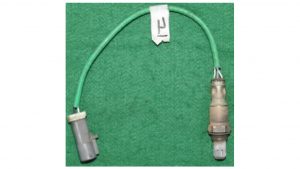
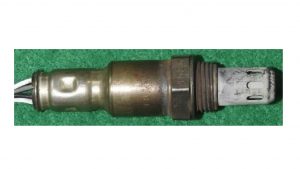

Probe has black residue deposit in the probe's protection tube.
Residues in the tube contaminate the sensing element, reducing response time and causing a series of vehicle problems:
Increased fuel consumption;
Increase in polluting gas emission levels;
Difficulty adjusting fuel on Flex vehicles;
Long-term adjustment offset;
Injection light on.
For Cause 1, check engine status, correcting any wear problems, excess pressure in the oil pan and lubricating oil level;
For causes 2 and 3, check Air/Fuel mixture condition. Black residue on the spark plugs and tailpipe indicate a rich mixture with the use of gasoline;
For Cause 4, check the vehicle's cooling system. Recirculation of coolant with the engine cold, indicate system problems;
For Cause 5, use good quality fuel.
for all causes, check the long term fit, A/F ratio (air/fuel) if it is compatible with the fuel used. If necessary, redo the A/F adjustment and parameterization of the injection system;
for all causes, replace probe with proper type, looking in the NTK application table.

Probe has red residue deposit in the protection tube.
Residues in the tube contaminate the sensing element, reducing response time and causing a series of vehicle problems:
Increased fuel consumption;
Increase in polluting gas emission levels;
Difficulty adjusting fuel on Flex vehicles;
Long-term adjustment offset;
Injection light on.
Use of poor quality fuel.
Use good quality fuel.
Check the long-term fit, A/F ratio (air/fuel) if it is compatible with the fuel used. If necessary, redo the A/F adjustment and parameterization of the injection system;
Replace probe with proper type, looking in the NTK application table.
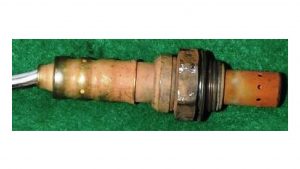
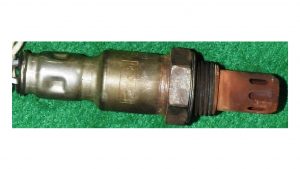

Probe has hole in sensing element filter, this hole can be caused by incorrect handling. (use of piercing tools near the sensor).
Water and dirt infiltration into the sensing element;
Incorrect sensor reading;
Negative signal generated by the sensor;
Increased fuel consumption;
Increase in polluting gas emission levels;
Difficulty adjusting fuel on Flex vehicles;
Long-term adjustment offset;
Injection light on;
incorrect handling;
Avoid using sharp tools near the sensor;
Check the long-term fit, A/F ratio (air/fuel) if it is compatible with the fuel used. If necessary, redo the A/F adjustment and parameterization of the injection system;
for all causes, replace probe with proper type, looking in the NTK application table.

Misalignment of the terminals on the probe connector and/or misaligned wire sealant in connector.
Infiltration of water and/or oil in the connector;
Incorrect sensor reading;
Increased fuel consumption;
Increase in polluting gas emission levels;
Difficulty adjusting fuel on Flex vehicles;
Long-term adjustment offset;
Injection light on;
For Cause 1, avoid pulling the sensor wires (pull the threads);
For Cause 2, avoid disassembling or unlocking connector wires;
for all causes, check the long term fit, A/F ratio (air/fuel) if it is compatible with the fuel used. If necessary, redo the A/F adjustment and parameterization of the injection system;
for all causes, replace probe with proper type, looking in the NTK application table.

Grommet (wire sealing rubber) torn or dented, affecting the seal of the sensing element.
Water and dirt infiltration into the sensing element;
Incorrect sensor reading;
Negative signal generated by the sensor;
Increased fuel consumption;
Increase in polluting gas emission levels;
Difficulty adjusting fuel on Flex vehicles;
Long-term adjustment offset;
Injection light on;
For Cause 1, avoid using piercing tools near the sensor;
For Cause 2, avoid leaving the wires too taut or without slack and/or incorrectly fixed. Moving the motor assembly can pull the probe wires;
For Cause 2, avoid loosening the connector by pulling on the wires.;
for all causes, check the long term fit, A/F ratio (air/fuel) if it is compatible with the fuel used. If necessary, redo the A/F adjustment and parameterization of the injection system;
for all causes, replace probe with proper type, looking in the NTK application table.

Presence of oil infiltration and/or water in the probe connector. In case of moisture, it can cause oxidation of the connector, in the case of oil, it can have a shiny appearance.
Infiltration of water and/or oil in the connector;
Incorrect sensor reading;
Negative signal generated by the sensor;
Increased fuel consumption;
Increase in polluting gas emission levels;
Difficulty adjusting fuel on Flex vehicles;
Long-term adjustment offset;
Injection light on;
For Cause 1, check and correct any fluid leaks in the regions close to the sensor. Avoid the application of pressurized water when washing engines;
For Cause 2, avoid the application of chemicals and lubricants on the probe connector;
For Cause 3, check and correct any leaks from sensors and actuators that compromise the engine electrical harness. If oil contamination occurs, check the need for changing the electrical harness.
for all causes, check the long term fit, A/F ratio (air/fuel) if it is compatible with the fuel used. If necessary, redo the A/F adjustment and parameterization of the injection system;
for all causes, replace probe with proper type, looking in the NTK application table.
Note: Fluids such as water and oil flow through the voids between the filaments of the threads (capillarity) reaching the sensing element, causing its contamination.
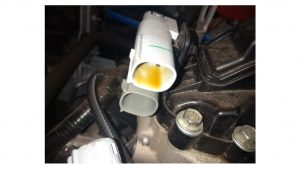

Hexagon with severe key marks and/or deformation on the body. Oxygen sensors are produced by a zirconium dioxide ceramic technology., and therefore impacts on the probe can break the sensor element.
Increased fuel consumption;
Increase in polluting gas emission levels;
Difficulty adjusting fuel on Flex vehicles;
Long-term adjustment offset;
Injection light on;
Probe reading by scanner with locked value.
For Cause 1, use the proper tool to remove and install the probe and in good condition;
For Cause 2, avoid impacts on the sensor body and exhaust collector. When traveling on roads with very uneven or unpaved paving, redouble your care and use compatible speed;
for all causes, check the long term fit, A/F ratio (air/fuel) if it is compatible with the fuel used. If necessary, redo the A/F adjustment and parameterization of the injection system;
for all causes, replace probe with proper type, looking in the NTK application table.

Broken probe wire and/or crushed, breaking the inner filaments of the strands.
Incorrect sensor reading;
Increased fuel consumption;
Increase in polluting gas emission levels;
Difficulty adjusting fuel on Flex vehicles;
Long-term adjustment offset;
Injection light on;
For Cause 1, avoid pulling the probe wire;
For Cause 2, make sure the harness is not too short, no free space to allow a certain displacement due to engine vibration;
For Cause 3, before releasing the probe, disconnect or connector.
for all causes, check the long term fit, A/F ratio (air/fuel) if it is compatible with the fuel used. If necessary, redo the A/F adjustment and parameterization of the injection system;
for all causes, replace probe with proper type, looking in the NTK application table.
